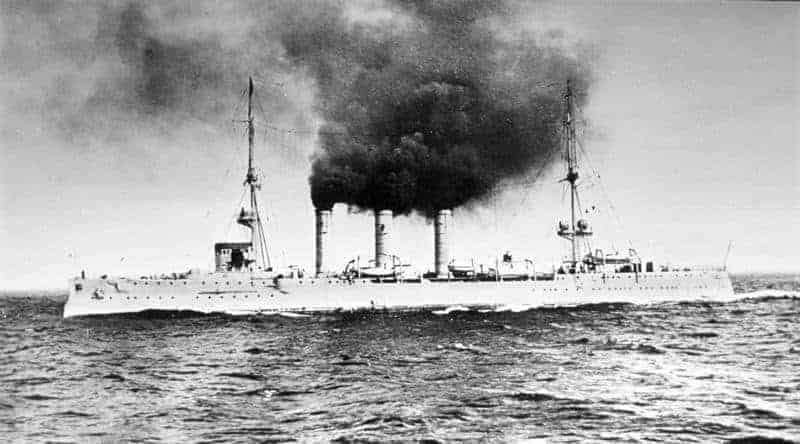The Imperial German Navy’s SMS Emden was a light cruiser that was completed in 1909, then sent to join the German East Asia Squadron, based in Tsingtao, China. Displacing about 4300 tons, she was armed with ten 4.1 inch guns and two torpedo tubes, which was a nice punch for a ship of her size. Between that and her ability to do nearly 24 knots – a good speed in those days – the Emden was well suited for her intended role of commerce raiding.
When World War I broke out, the Emden, with a complement of 18 officers and 343 crewmen, commanded by an intrepid commander named Karl von Mueller, set out to fulfill her mission. During a two month cruise in the Indian Ocean, she captured or destroyed over 30 ships, bombed Madras, raided Penang in the Malay Peninsula, and sank an enemy cruiser and destroyer. She was eventually cornered by a more powerful ship and forced to run aground. However, even that did not end her story: some of her crew who had been stranded on an island seized a rickety ship, and sailed their way to freedom in an epic journey that captivated friend and foe alike.

The Epic Cruise of the Emden
In the weeks preceding the war’s outbreak, the Emden was the only German cruiser in East Asian waters. Fearing that war might start at any moment, her captain took the precaution of sailing out to the high seas, lest she be surprised at port, and cornered and sunk by a more powerful enemy. It turned out to be a wise move, as a powerful joint British-Japanese assault, against which the Emden would have stood no chance, fell upon her home port of Tsingtao soon after the war began.
On August 3rd, 1914, one day after Germany declared war on Russia, the Emden captured a Russian ship and sent her back to Tsingtao, where she was converted into an auxiliary commerce raider. The Emden then sailed to the Marianas Islands in the Pacific, where the rest of the German East Asia Squadron was gathering. Upon hearing that Japan was about to join the Entente, the odds against German naval operations in East Asian waters became too great. So it was determined that the squadron should sail instead across the Pacific, around South America, and into the Atlantic. However, the Emden was detached to operate independently as a commerce raider.
Captain von Mueller then disguised his ship by rigging a dummy fourth smokestack, which made the Emden look like the roughly same sized British cruiser HMS Yarmouth. With that disguise in place, the German cruiser’s preferred tactic became to approach target vessels with no colors flying, in the hope that they would mistake her for a British warship. When she got close enough, the Emden would suddenly fire a warning shot while simultaneously hoisting the German flag and signaling the prey: “Stop at once! Do not use wireless!”

In just a few days, the Emden seized or sank 15 ships, and the total number of her victims eventually exceeded 30. As panic gripped the region, few ships ventured from harbor, so Captain von Mueller expanded his operations by shelling targets on land. On the night of September 22nd, the Emden steamed into the port of Madras, turned her guns on the fuel depots, and opened a 30 minute barrage that set the massive fuel tanks ablaze.
Von Mueller then sailed to the British port of Diego Garcia, sinking six more ships along the way. Upon arriving, the Germans were astonished to discover that the locals were unaware that war had been declared. Keeping mum, they eschewed wrecking the place, and instead took the opportunity to re-provision, repair, and even repaint the Emden. In an act of decency, von Mueller refrained from destroying the still unsuspecting port when he left, and even had his crewmen help repair a local’s vessel. From Diego Garcia, the Emden sailed to Penang in British Malaya, arriving at dawn on October 27th, where she encountered an anchored Russian cruiser and a French destroyer, and catching them off guard, destroyed both.

